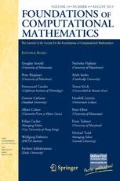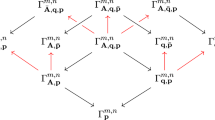Abstract
The distortion varieties of a given projective variety are parametrized by duplicating coordinates and multiplying them with monomials. We study their degrees and defining equations. Exact formulas are obtained for the case of one-parameter distortions. These are based on Chow polytopes and Gröbner bases. Multi-parameter distortions are studied using tropical geometry. The motivation for distortion varieties comes from multi-view geometry in computer vision. Our theory furnishes a new framework for formulating and solving minimal problems for camera models with image distortion.


Similar content being viewed by others
References
E. Arnold, Modular algorithms for computing Gröbner bases, J. Symbolic Comput. 35 (2003) 403–419.
C. Bocci, E. Carlini and J. Kileel, Hadamard products of linear spaces, J. Algebra 448 (2016) 595–617.
M. Bujnak, Algebraic solutions to absolute pose problems, Doctoral Thesis, Czech Technical University in Prague, 2012.
M. Bujnak, Z. Kukelova, and T. Pajdla, 3D reconstruction from image collections with a single known focal length, in Proceedings of the 2009 IEEE International Conference on Computer Vision (ICCV 2009), pp. 351–358.
M. Bujnak, Z. Kukelova and T. Pajdla, Making minimal solvers fast, in Proceedings of the 2012 IEEE Conference on Computer Vision and Pattern Recognition (CVPR 2012), pp. 1506–1513.
M. Byrod, Z. Kukelova, K. Josephson, T. Pajdla and K. Åström, Fast and robust numerical solutions to minimal problems for cameras with radial distortion, in Proceedings of the 2008 IEEE Conference on Computer Vision and Pattern Recognition (CVPR 2008), pp. 1–8.
E. Cattani, M. A. Cueto, A. Dickenstein, S. Di Rocco and B. Sturmfels, Mixed discriminants, Math. Z. 274 (2013) 761–778.
D. Cox, J. Little and H. Schenck, Toric varieties, Graduate Studies in Mathematics 124, American Mathematical Society, Providence, 2011.
J. Dalbec and B. Sturmfels, Introduction to Chow forms, in Invariant methods in discrete and computational geometry (N. White, ed.), Springer, New York, 1995, pp. 37–58.
M. Démazure, Sur deux problèmes de reconstruction, Technical Report 882, INRIA, Rocquencourt, 1988.
S. Di Rocco, Linear toric fibrations, in Combinatorial algebraic geometry, Lecture Notes in Mathematics 2108, Springer, Cham, 2014, pp. 119–147.
D. Eisenbud and J. Harris, On varieties of minimal degree (a centennial account), in Algebraic geometry, Bowdoin 1985, Part 1, Proceedings of Symposia in Pure Mathematics 46 (S.J. Bloch, ed.), American Mathematics Society, Providence, 1987, pp. 3–13.
J.-C. Faugère, A new efficient algorithm for computing Gröbner bases (F4), J. Pure Appl. Algebra 139 (1999) 61–88.
M. Fischler and R. Bolles, Random sample consensus: a paradigm for model fitting with applications to image analysis and automated cartography, Commun. ACM 24 (1981) 381–395.
A. Fitzgibbon, Simultaneous linear estimation of multiple view geometry and lens distortion, in Proceedings of the 2001 IEEE Conference on Computer Vision and Pattern Recognition (CVPR 2001), pp. 125–132.
G. Fløystad, J. Kileel and G. Ottaviani, The Chow form of the essential variety in computer vision, J. Symbolic Comput., to appear.
I.M. Gel’fand, M.M. Kapranov and A.V. Zelevinsky, Discriminants, resultants and multidimensional determinants, Birkhäuser, Boston, 1994.
D. Grayson and M. Stillman, Macaulay2, a software system for research in algebraic geometry, available at www.math.uiuc.edu/Macaulay2/.
J. Harris, Algebraic geometry: a first course, Graduate Texts in Mathematics 133, Springer-Verlag, New York, 1992.
R. Hartley and A. Zisserman, Multiple view geometry in computer vision, Cambridge University Press, 2nd ed., Cambridge, 2003.
A. Jensen, Gfan, a software system for Gröbner fans and tropical varieties, Available at http://home.imf.au.dk/jensen/software/gfan/gfan.html.
F. Jiang, Y. Kuang, J.E. Solem and K. Åström, A minimal solution to relative pose with unknown focal length and radial distortion, in Proceedings of the 2014 Asian Conference on Computer Vision (ACCV 2014), pp. 443–456.
M. Kapranov, B. Sturmfels and A. Zelevinski, Chow polytopes and general resultants, Duke Math. J. 67 (1992) 189–218.
Y. Kuang, J.E. Solem, F. Kahl and K. Åström, Minimal solvers for relative pose with a single unknown radial distortion, in Proceedings of 2014 IEEE Conference on Computer Vision and Pattern Recognition (CVPR 2014), pp. 33–40.
Z. Kukelova, Algebraic Methods in Computer Vision, Doctoral Thesis, Czech Technical University in Prague, 2013.
Z. Kukelova, M. Bujnak and T. Pajdla, Automatic Generator of Minimal Problem Solvers, in Proceedings of the 2008 European Conference on Computer Vision (ECCV 2008), Lecture Notes in Computer Science 5304, Springer 2008, pp. 302–315.
D. Maclagan and B. Sturmfels, Introduction to Tropical Geometry, Graduate Studies in Mathematics 161, American Mathematical Society, 2015.
B. Micusik and T. Pajdla, Structure from motion with wide circular field of view cameras, IEEE T. Pattern Anal. 28 (2006) 1135–1149.
G. Newsam, D. Q. Huynh, M. Brooks and H. P. Pan, Recovering unknown focal lengths in self-calibration: an essentially linear algorithm and degenerate configurations. ISPRS J. Photogramm., vol. XXXI-B3 (1996), 575–580.
D. Nistér, An efficient solution to the five-point relative pose problem, IEEE T. Pattern Anal. 26 (2004) 756–770.
S. Petrović, On the universal Gröbner bases of varieties of minimal degree, Math. Res. Lett. 15 (2008) 1211–1221.
H. Stewenius, D. Nistér, F. Kahl and F. Schaffalitzky, A minimal solution for relative pose with unknown focal length, in Proceedings of the 2005 IEEE Computer Society Conference on Computer Vision and Pattern Recognition (CVPR 2005), pp. 789–794.
P. Sturm, On focal length calibration from two views, in Proceedings of the 2001 IEEE Conference on Computer Vision and Pattern Recognition (CVPR 2001), pp. 145–150.
B. Sturmfels, Gröbner bases and convex polytopes, American Mathematical Society, University Lectures Series 8, Providence, 1996.
B. Sturmfels, Solving systems of polynomial equations, American Mathematical Society, CBMS Regional Conferences Series 97, Providence, 2002.
C. Traverso, Gröbner trace algorithms, in Proceedings of the 1988 International Symposium of Symbolic and Algebraic Computation (ISSAC 1988), Lecture Notes in Computer Science 358 (P. Gianni, ed.), Springer-Verlag, Berlin Heidelberg, 1989, pp. 125–138.
Acknowledgements
This project started at the Algebraic Vision workshop (May 2016) at the American Institute of Mathematics (AIM) in San Jose. We are grateful to the organizers, Sameer Agarwal, Max Lieblich and Rekha Thomas, for bringing us together. Joe Kileel and Bernd Sturmfels were supported by the US National Science Foundation (DMS-1419018). Zuzana Kukelova was supported by the Czech Science Foundation (GACR P103/12/G084). Part of this study was carried out while she worked for Microsoft Research, Cambridge, UK. Tomas Pajdla was supported by H2020-ICT-731970 LADIO, the Robotics for Industry 4.0 Project CZ.02.1.01/0.0/0.0/15_003/0000470 and the European Regional Development Fund.
Author information
Authors and Affiliations
Corresponding author
Additional information
Communicated by Joseph M. Landsberg.
Rights and permissions
About this article
Cite this article
Kileel, J., Kukelova, Z., Pajdla, T. et al. Distortion Varieties. Found Comput Math 18, 1043–1071 (2018). https://doi.org/10.1007/s10208-017-9361-0
Received:
Revised:
Accepted:
Published:
Issue Date:
DOI: https://doi.org/10.1007/s10208-017-9361-0




